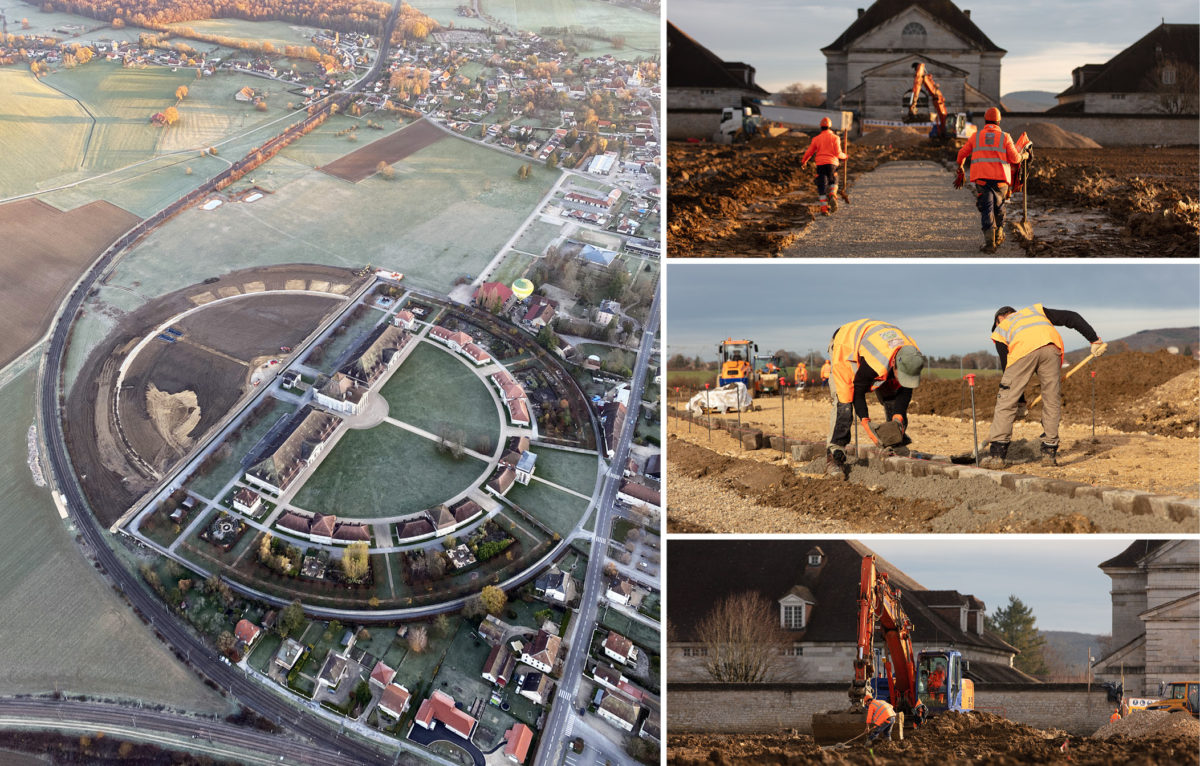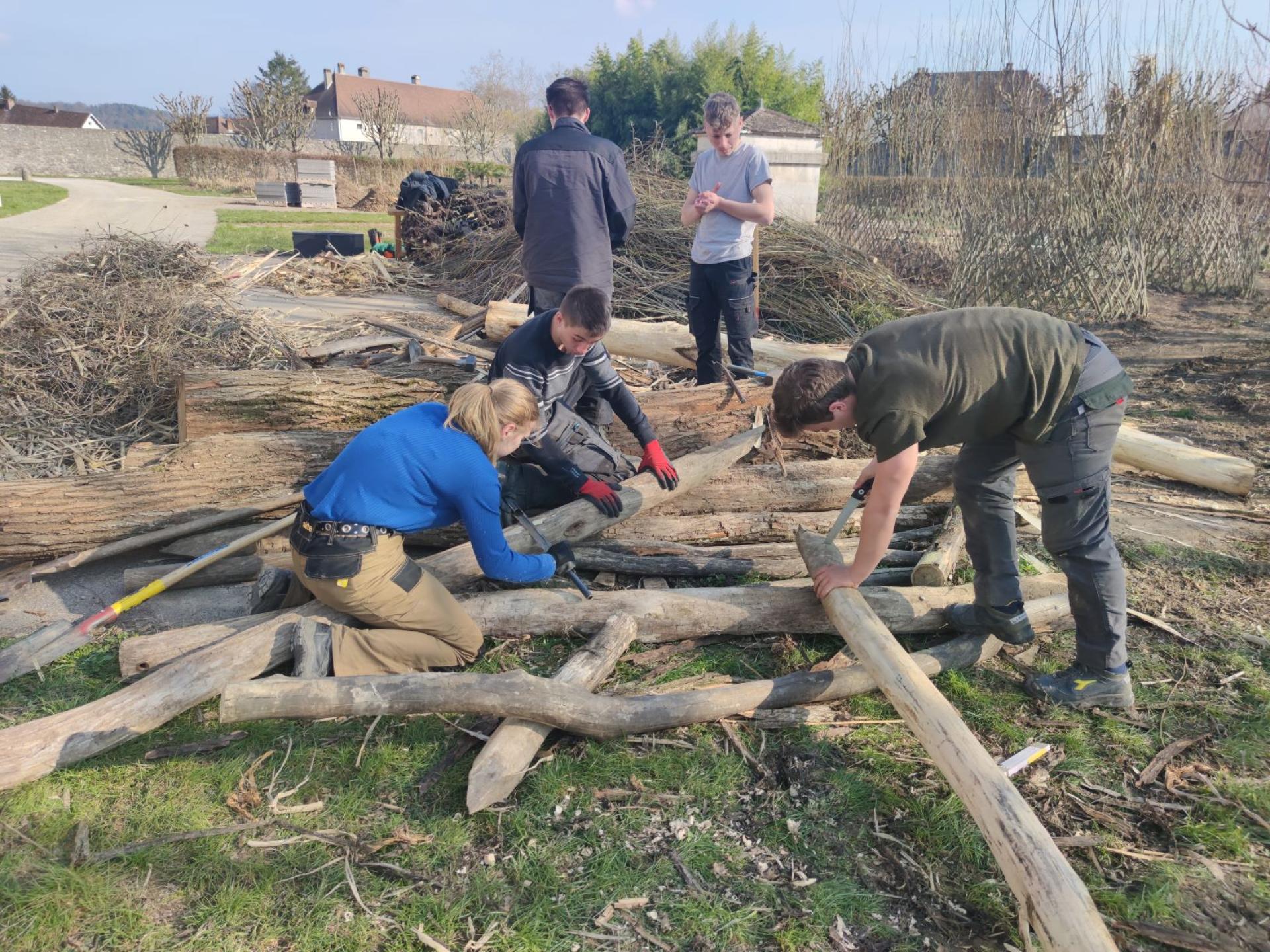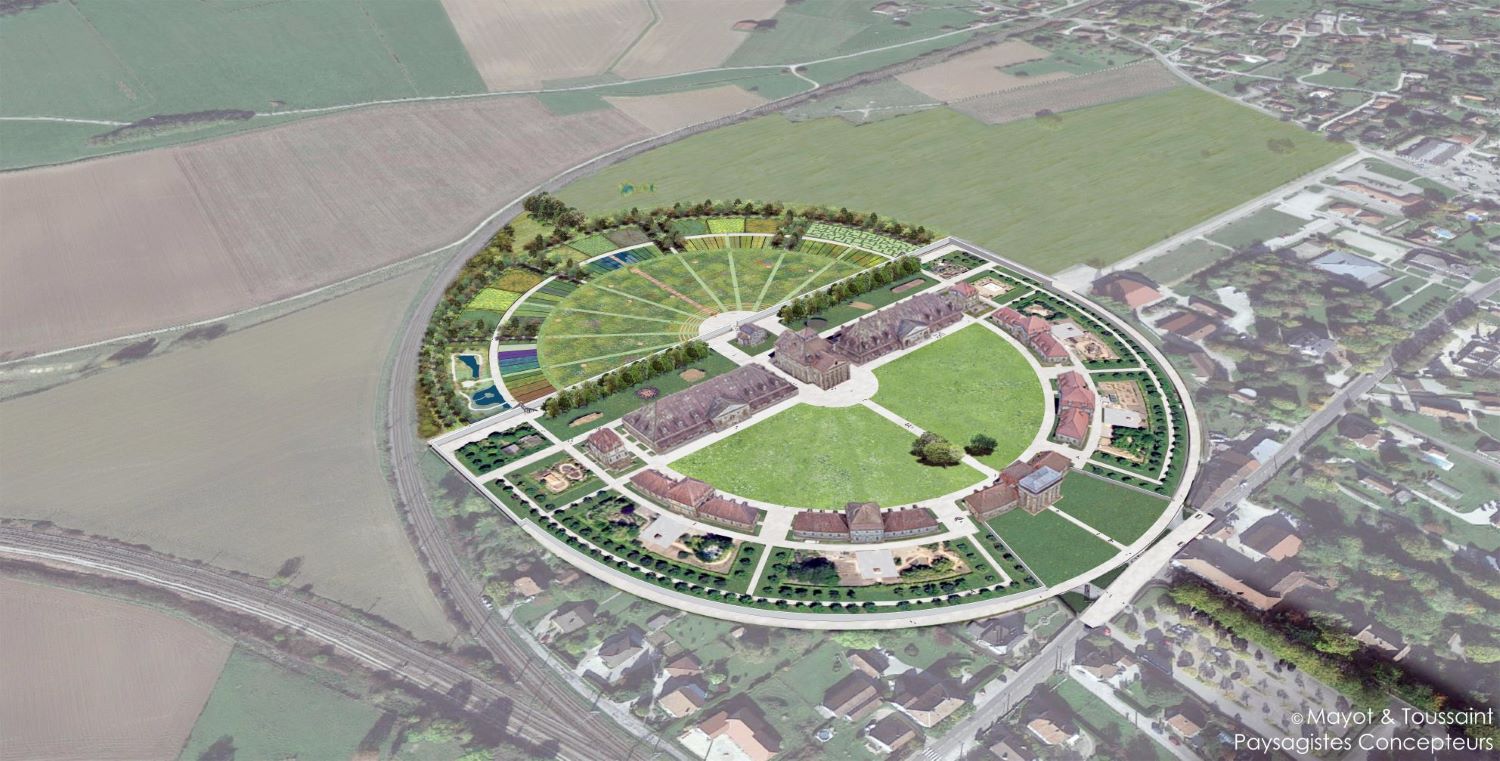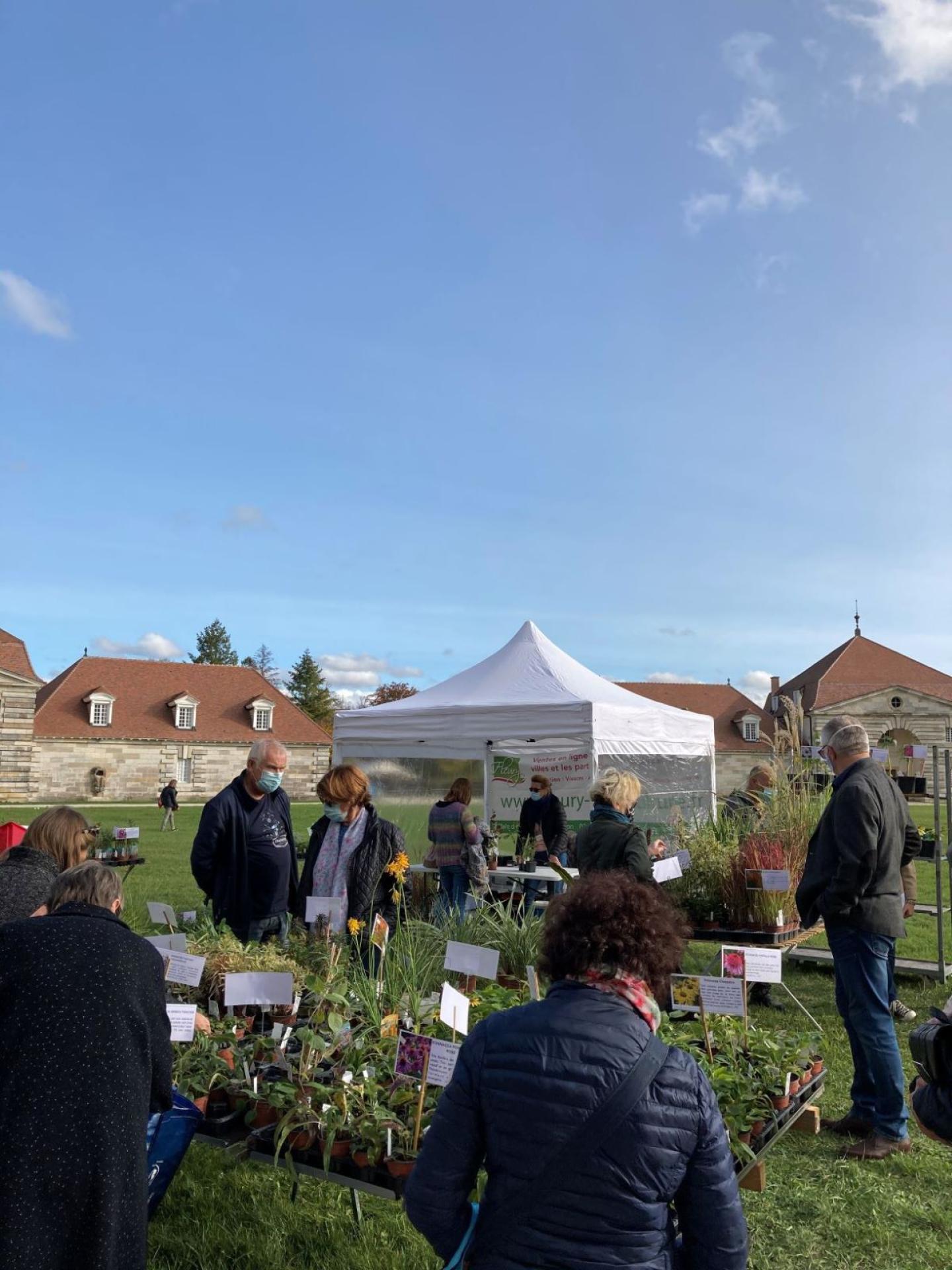Un Cercle Immense
Basic information
Project Title
Full project title
Category
Project Description
The project « Un Cercle Immense » aims to make visible the dream of an ideal city in the shape of a circle, imagined in the 18th century by Claude Nicolas Ledoux, architect of the Royal Saltworks. Beyond the desire to make the former salt factory an international and contemporary reference for the creation of gardens, the Royal Saltworks wants to position itself as a laboratory for the landscape professions, combining experimentation, circular economy, education and high environmental quality.
Project Region
EU Programme or fund
Description of the project
Summary
In 1982, the Arc-et-Senans Royal Saltworks was included on the UNESCO world heritage list. Designed by Claude-Nicolas Ledoux (1736-1806), a visionary architect during the Enlightenment period, the Royal Saltworks site is a rare and an exceptional example of industrial architecture history. The site was designed for the production of salt, commissioned by Louis XV, and built between 1775 and 1779.
Presently, the former salt factory is developing « Un Cercle immense », a landscaping project inspired by the legacy of the architect Claude-Nicolas Ledoux, who dreamed in the 18th century of an ideal city in the shape of a circle around the Royal Saltworks.
With the landscapers Gilles Clément, Vincent Mayot and Leïla Toussaint, we have developed 20 gardens on 15 hectares to make the Royal Saltworks a school of “planetary gardens” combining integration, education, creation and high environmental quality, creating a unique island of biodiversity in Eastern France.
The gardens of « Un Cercle Immense » are dedicated to the transmission of knowledge (permaculture, ancient cereals, aromatic and medicinal plants, soil treatment, water management...), they constitute the basis of an ambitious educational and civic project in which we involve more than 400 students and 30 schools each year.
The priority given to respecting the natural resources of the site is a challenge, a source of creativity and a learning springboard for the students: limiting to the maximum waterproofing of the grounds, the use of mulching to limit the drying out of the soil, developing a composting system within the site, favouring local materials and plant species that do not require watering, etc. Classified as a Sensitive Natural Area, and labelled as a refuge for the protection’s League of birds, the Royal Salt Works has been managed in a zero-phyto manner since 2014.
Key objectives for sustainability
Biodiversity provides irreplaceable services to humanity: oxygen, food, medicines. The global use of resources poses major problems: climate change, collapse of biodiversity, yet we do not have a second planet.
The ambition of the project « Un Cercle Immense » is to embrace the vision of landscaper and committed citizen Gilles Clément to meet the needs of the present without compromising the capacities of future generations.
He has developed the concept of the “planetary garden”, where the Earth is -like a garden- a closed and finite space that it is up to man to maintain and preserve. Gilles Clément's ambition is to establish a school of the “planetary Garden” at the Saltworks. The challenge is to awaken individual and collective potential, to share knowledge and techniques to produce with living organisms, and not against them. The aim is to give everyone the tools to live better, to cooperate, to help each other and build together a more sustainable and united future.
At the Royal Saltworks this is achieved by planting more than 400 trees (some of which are suitable for the development of cavities to accommodate birds, chiropterans and insects, for example), the creation of ponds to encourage the Natterjack Toad, basins to accommodate dragonflies, and the absence of permanent lighting to ensure a nocturnal environment favourable to the living environment and its biodiversity. In the 20 gardens created, the permaculture mounds and the vegetable garden will develop the circular economy by supplying the restaurant, which in return will provide food waste to feed the chickens.
The Royal Salt Works is committed to the search for solutions to the ecological emergency that are of high landscape and architectural quality, creative, forward-thinking, visionary, sustainable and favouring biodiversity.
Key objectives for aesthetics and quality
The exceptional quality of the current heritage site is recognised as much for its architecture as for its industrial history and, more recently, for the exemplary management of the natural spaces that it shelters and enhances.
The project « Un Cercle Immense » is rooted in Claude-Nicolas Ledoux's masterpiece, the former salt factory, a UNESCO World Heritage Site. The very genesis of the project is centuries old and refers to the architect's dream of creating an ideal city in the shape of a circle, imagined in the 18th century.
The new landscaping was designed around the idea of Gilles Clément's “garden in motion”. The 120,000 annual visitors can now enjoy the beauty of the plants and their multiple interests that change with the seasons. The “garden in motion” is a place where plant species can develop freely and where the role of the gardener is redefined because it gives a central place to observation and cooperation with nature.
The beauty of the soil, of seeds, of life and their adaptation to future climate change are the predominant themes. The plant, by integrating light into matter, is the true demiurge of our planet. Without it, there is no atmosphere, no soil, no life as we know it today. This is what the project « Un Cercle Immense » celebrates.
These new gardens are accompanied by a philosophical walk where quotes from the famous architect Claude Nicolas Ledoux are hung on the paths leading to the gardens. This allows for a real poetic immersion that is anchored in the deep vision of the project by giving a way to the future of our societies at the time of global warming.
Finally, the Royal Saltworks becomes a place where more than ever "everything seems art and everything seems nature", as Claude Nicolas Ledoux stated in the 18th century. He already was at the service of the future, as the Royal Saltworks is today.
Key objectives for inclusion
The Royal Saltworks is committed to welcoming all types of visitors and to make its monument accessible to people with visual, hearing, mental and physical disabilities. This desire naturally infuses the project « Un Cercle Immense ». Indeed, all the paths are accessible to people with reduced mobility, and an important work of mediation is deployed for each of the so-called impaired public. The workshops are rooted in the themes of the gardens, such as "smells and colours", based on the experiential and sensory.
The mediation team -reinforced with the need of « Un Cercle Immense »- also carries out specific work for school children, and welcomes 6,000 pupils from the region every year.
The history of the Royal Saltworks has been deeply linked to its territory in recent years, insofar as one of the main themes is to develop relations with the local population.
The program is designed to meet the expectations of local visitors, and the inhabitants of Arc-et-Senans benefit from free admission. Overall, the Royal Saltworks has decided not to increase the price of the ticket with the arrival of the project « Un Cercle Immense » to allow for the largest possible number of people to be able to afford it.
Since 2016, a sound and light show on the facades of the Royal Salt Works has brought together more than 800 amateur volunteer extras from the local area each year. Participants collaborate on a unique scenographic experience. We are currently working on this principle with even more volunteers for a specific show highlighting « Un Cercle Immense ».
An amateur gardeners' club is also being developed, to create an environmentally friendly place to live, through education and openness.
Results in relation to category
Preserving and promoting the heritage of the Royal Saltworks is the permanent priority of our public institution. The Royal Saltworks has been a UNESCO listed historic monument since 1982, has held the Heritage Site for Culture label since 1973 and the Quality Tourism label since 2014. It is also located between two Natura 2000 zones and is classified as a Refuge by the French League for the Protection of Birds.
For the first time, a plant and landscape development will reveal to the general public the universal value of a UNESCO monument that had remained largely invisible until now (since the Ideal City of Chaux remained a paper project in Ledoux's architecture treaty published in 1804). The project « Un Cercle Immense » makes visible, and even visitable for the first time, the initial spirit of Ledoux's project that made so many architects and artists dream after it. It makes perceptible at first glance the reasons why the Royal Saltworks was one of the very first sites to be registered on the World Heritage List.
In order to enhance the heritage of the site, the project has made it possible to study and thus better conserve the fantastic natural richness of the area. This is the case for the many protected species at the European level that are present at the Royal Saltworks: Athena's owl, the Barn Owl, the Stilt-Eared Bunting, the Natterjack Toad, the Jackdaw. The site hosts the largest breeding colony of the Great Rhinolophus in France (1200 individuals) as well.
In addition to planting 400 trees and creating 20 gardens, 18,000 young people will be trained and made aware of the landscape and biodiversity professions. Six jobs will be created for a total of €4 million in local economic impact per year. We are now at the beginning of the project and 3 jobs have already been created.
How Citizens benefit
« Un Cercle Immense » is a place of knowledge transmission that benefits the general public through the quality and diversity of observable plant species. Indeed, visitors can visit 15 hectares composed of 20 gardens and discover an abundant biodiversity, accompanied by awareness-raising panels.
Many visitors have expressed an interest in participating in a garden club at the Royal Saltworks, and we are in the process of creating one with them.
Beyond the general public, this project is largely intended for students, experts, scientists, and actors of the environment. The design of the Festival's gardens is conceived by student landscape gardeners and realized by student gardeners.
This desire for openness is also intended to speak to experts, scientists and environmental actors in the region, who have been invited to give their insights through a "Biodiversity Advisory Committee" created within the framework of « Un Cercle Immense ». This committee wants to initiate a collective reflection taking root on the territory of the Royal Salt Works and inviting the different stakeholders to make those 15 hectares their field of experimentation.
These students, pupils, scientists and field workers are creating a real laboratory for the landscape professions combining experimentation, circular economy, pedagogy and high environmental quality.
This led us to use specific seeds from local tree nurseries. We also have collaborated with local associations to build the hedges between the gardens as much as possible in accordance with its environment (leave a passage for hedgehogs for example).
The farmers who used the grassland on which the project was established were fully included in the various design phases and were given neighbouring plots on which to continue their late mowing.
Innovative character
Beyond the exceptional character of a UNESCO World Heritage Site transformation, the concept behind « Un Cercle Immense » itself is quite innovative.
Indeed, the expansion of a UNESCO World Heritage Site is highly unusual and rarely accepted. This acceptance for the Royal Saltworks shows the innovative character but also the logical and natural character if one looks at the history of the place.
But it is the concept itself that gives this project its singular audacity. It is indeed the first time that a heritage building of this scale has embraced committed ideas such as those of the landscaper Gilles Clément, which are at odds with the classic maintenance of French gardens.
His philosophy is to seek how to exploit diversity without destroying it, and to make man the guarantor of diversity.
In the end, his approach can be summarised as follows: "Do as much as possible with, as little as possible against". This process enables a flower to grow in the middle of a path, because it has chosen its place. The Royal Salt Works, with « Un Cercle Immense », wants to convey the idea that listening to the vegetal environment and observing plants is fundamental for our future generations. And it is precisely on young people that the project « Un Cercle Immense » is based, to surprise and communicate on climate change. It is the landscape students to whom the design of the gardens of « Un Cercle Immense » is entrusted, with the aim of passing on a message that is both educational and artistic.
The other innovative aspect of the project is its experimental nature at all stages of design, management method, and for all types of trades involved in the project. Indeed, this can range from experimentation on seed growth to the use of specific equipment for the installation of the electrical network.





